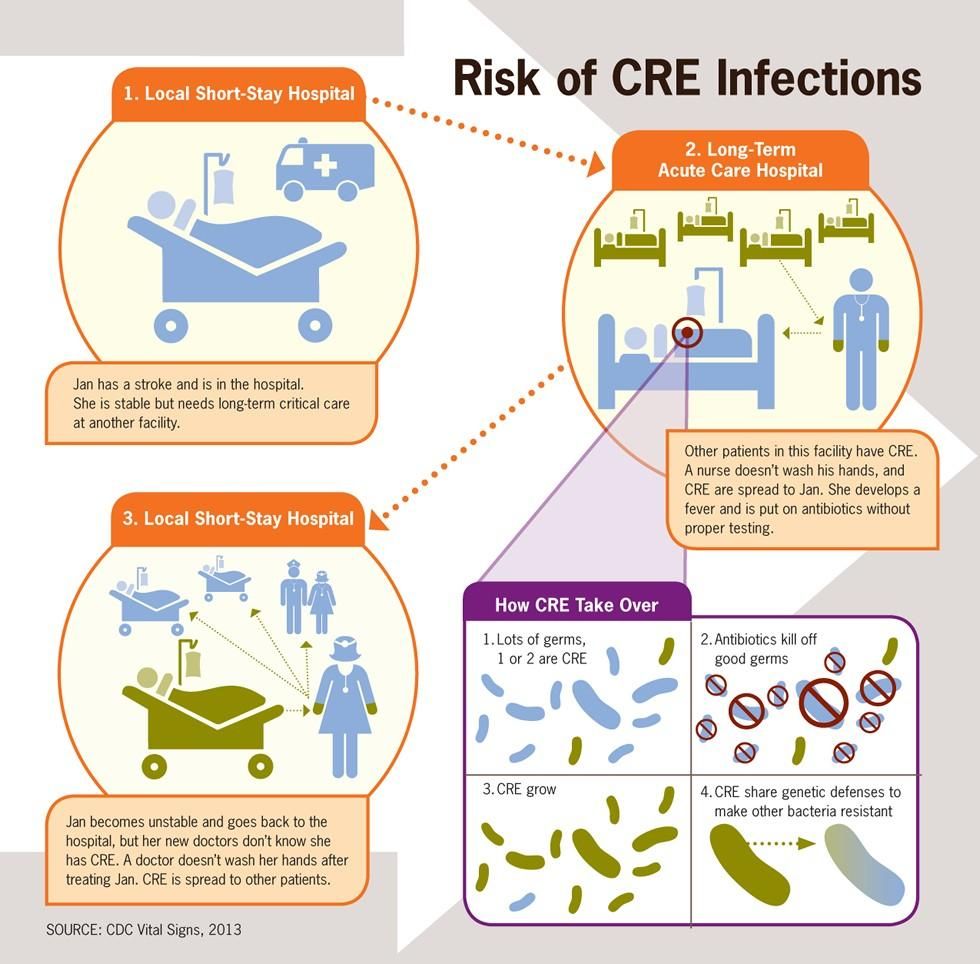

SUBSCRIBE TO OUR FREE NEWSLETTER
Daily news & progressive opinion—funded by the people, not the corporations—delivered straight to your inbox.
5
#000000
#FFFFFF
To donate by check, phone, or other method, see our More Ways to Give page.


Daily news & progressive opinion—funded by the people, not the corporations—delivered straight to your inbox.
There is an alarming rise in antibiotic resistant, deadly "nightmare bacteria," the Centers for Disease Control and Prevention (CDC) reported on Tuesday.
The warning regards carbapenem-resistant Enterobacteriaceae (CRE), a family of germs, the CDC explains, that "have become resistant to all or nearly all the antibiotics we have today."
"CRE are nightmare bacteria," CDC Director Tom Frieden, M.D., M.P.H, said in a statement. "Our strongest antibiotics don't work and patients are left with potentially untreatable infections."
Enterobacteriaceae germs (E. coli is an example) normally exist in the gut, but can become resistant to carbapenems, known as "last resort antibiotics." The germs may then travel to areas in the body they don't normally exist, often striking patients in hospitals and nursing homes on ventilators or catheters.
While infections from CRE germs are uncommon, they are particularly deadly, killing up to half of people who get severe infections from them. Their spreading capabilities are also a factor, as they can transfer their antibiotic resistance to other bacteria within their family. And these infections are on the rise, says the CDC, with the most common type of CRE infection increasing seven-fold over the last decade.
The infections in otherwise healthy people have been rare so far, but the CDC warns that the new data show that may change.
The CDC says the findings must be a call for urgent action on coordinated prevention efforts.
"Doctors, hospital leaders, and public health, must work together now to implement CDC's 'detect and protect' strategy and stop these infections from spreading," said Frieden.
The CDC has this infographic on the rise of CRE infections:

Read the full report here.
___________________________________
Dear Common Dreams reader, The U.S. is on a fast track to authoritarianism like nothing I've ever seen. Meanwhile, corporate news outlets are utterly capitulating to Trump, twisting their coverage to avoid drawing his ire while lining up to stuff cash in his pockets. That's why I believe that Common Dreams is doing the best and most consequential reporting that we've ever done. Our small but mighty team is a progressive reporting powerhouse, covering the news every day that the corporate media never will. Our mission has always been simple: To inform. To inspire. And to ignite change for the common good. Now here's the key piece that I want all our readers to understand: None of this would be possible without your financial support. That's not just some fundraising cliche. It's the absolute and literal truth. We don't accept corporate advertising and never will. We don't have a paywall because we don't think people should be blocked from critical news based on their ability to pay. Everything we do is funded by the donations of readers like you. Will you donate now to help power the nonprofit, independent reporting of Common Dreams? Thank you for being a vital member of our community. Together, we can keep independent journalism alive when it’s needed most. - Craig Brown, Co-founder |
There is an alarming rise in antibiotic resistant, deadly "nightmare bacteria," the Centers for Disease Control and Prevention (CDC) reported on Tuesday.
The warning regards carbapenem-resistant Enterobacteriaceae (CRE), a family of germs, the CDC explains, that "have become resistant to all or nearly all the antibiotics we have today."
"CRE are nightmare bacteria," CDC Director Tom Frieden, M.D., M.P.H, said in a statement. "Our strongest antibiotics don't work and patients are left with potentially untreatable infections."
Enterobacteriaceae germs (E. coli is an example) normally exist in the gut, but can become resistant to carbapenems, known as "last resort antibiotics." The germs may then travel to areas in the body they don't normally exist, often striking patients in hospitals and nursing homes on ventilators or catheters.
While infections from CRE germs are uncommon, they are particularly deadly, killing up to half of people who get severe infections from them. Their spreading capabilities are also a factor, as they can transfer their antibiotic resistance to other bacteria within their family. And these infections are on the rise, says the CDC, with the most common type of CRE infection increasing seven-fold over the last decade.
The infections in otherwise healthy people have been rare so far, but the CDC warns that the new data show that may change.
The CDC says the findings must be a call for urgent action on coordinated prevention efforts.
"Doctors, hospital leaders, and public health, must work together now to implement CDC's 'detect and protect' strategy and stop these infections from spreading," said Frieden.
The CDC has this infographic on the rise of CRE infections:

Read the full report here.
___________________________________
There is an alarming rise in antibiotic resistant, deadly "nightmare bacteria," the Centers for Disease Control and Prevention (CDC) reported on Tuesday.
The warning regards carbapenem-resistant Enterobacteriaceae (CRE), a family of germs, the CDC explains, that "have become resistant to all or nearly all the antibiotics we have today."
"CRE are nightmare bacteria," CDC Director Tom Frieden, M.D., M.P.H, said in a statement. "Our strongest antibiotics don't work and patients are left with potentially untreatable infections."
Enterobacteriaceae germs (E. coli is an example) normally exist in the gut, but can become resistant to carbapenems, known as "last resort antibiotics." The germs may then travel to areas in the body they don't normally exist, often striking patients in hospitals and nursing homes on ventilators or catheters.
While infections from CRE germs are uncommon, they are particularly deadly, killing up to half of people who get severe infections from them. Their spreading capabilities are also a factor, as they can transfer their antibiotic resistance to other bacteria within their family. And these infections are on the rise, says the CDC, with the most common type of CRE infection increasing seven-fold over the last decade.
The infections in otherwise healthy people have been rare so far, but the CDC warns that the new data show that may change.
The CDC says the findings must be a call for urgent action on coordinated prevention efforts.
"Doctors, hospital leaders, and public health, must work together now to implement CDC's 'detect and protect' strategy and stop these infections from spreading," said Frieden.
The CDC has this infographic on the rise of CRE infections:

Read the full report here.
___________________________________